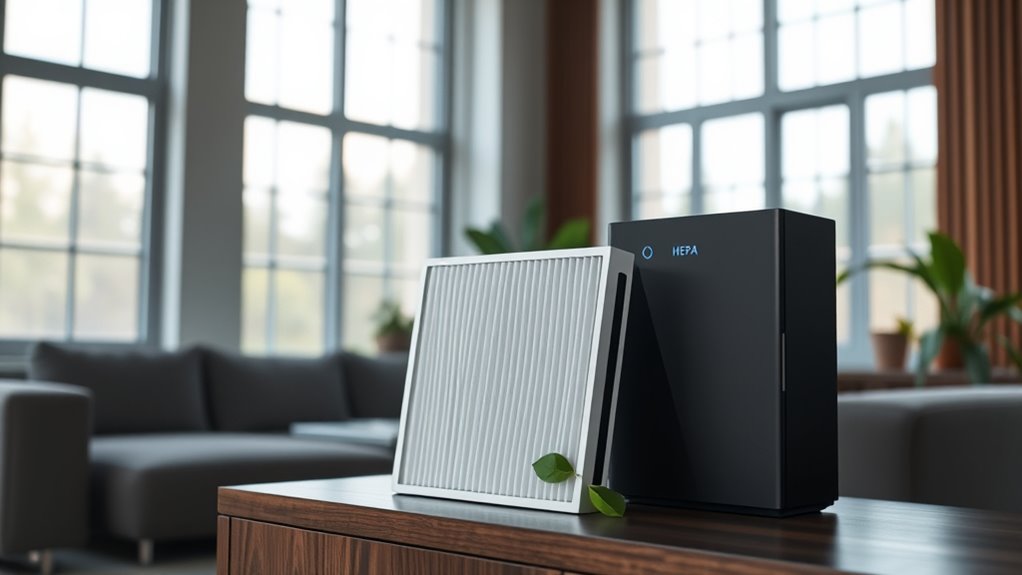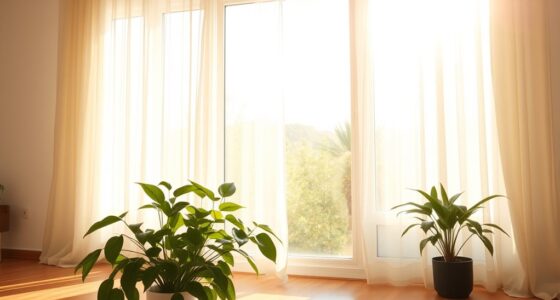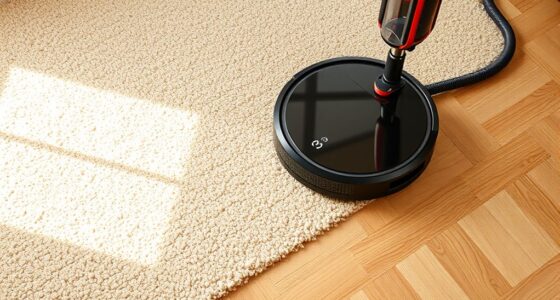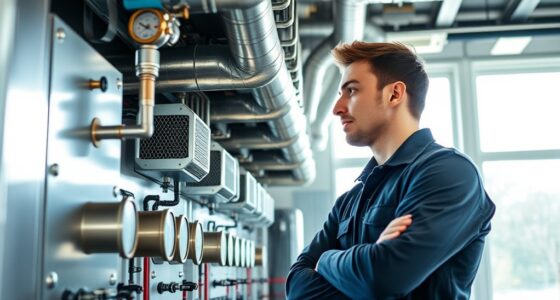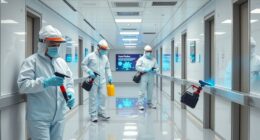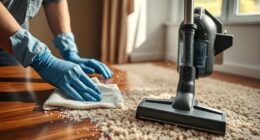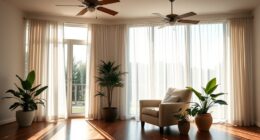To get the best results from your air cleaner and HEPA filter, use them consistently and follow the recommended schedule for replacing filters every 6 to 12 months, depending on your environment. Place your device in a central spot, away from walls or furniture, and keep windows closed during operation. Check for signs like musty smells or reduced airflow to know when it’s time for a change. Keep exploring to learn more tips for ideal use.
Key Takeaways
- Use air cleaners continuously during high pollution or allergy seasons for optimal indoor air quality.
- Place units centrally, away from walls and furniture, to ensure effective airflow and filtration.
- Regularly check and replace HEPA filters every 6 to 12 months or as indicated by device alerts.
- Keep windows and doors closed when using the purifier to maximize its effectiveness.
- Maintain and clean the device periodically to ensure safe, efficient operation and prolonged lifespan.

Have you ever wondered how you can improve the air quality in your home or office? Using air cleaners and HEPA filters effectively can make a significant difference, but it requires some understanding of proper maintenance and timing. One of the most important aspects is air purifier maintenance, which includes adhering to a filter replacement schedule. When you keep your filters clean and replace them at the right intervals, your air purifier performs at its best, capturing allergens, dust, and other pollutants efficiently.
Knowing when to replace filters is key. Most HEPA filters need changing every 6 to 12 months, depending on usage and air quality. If you notice a decline in your air purifier’s performance or a musty smell, it’s probably time to swap out the filter. Regular maintenance isn’t just about keeping the device running—it’s about ensuring that you’re breathing cleaner air. Some units have indicator lights that signal when a filter needs replacing, but if yours doesn’t, mark it on your calendar. Setting a reminder helps you stay consistent and avoid forgetting, which can lead to reduced filtration effectiveness over time.
Most HEPA filters should be replaced every 6 to 12 months for optimal performance.
Besides replacing filters on schedule, it’s essential to keep the air purifier itself clean. Dust and debris can accumulate on vents and fans, hindering airflow and decreasing efficiency. Wiping down exterior surfaces and cleaning pre-filters, if your unit has them, will prolong the lifespan of your device and maintain peak performance. Proper air purifier maintenance also involves checking for any damage or malfunction periodically, ensuring that the device functions safely and effectively. Regular filter replacement is especially important because HEPA filtration captures tiny particles that can affect your health and overall air quality.
Using your air cleaner correctly is equally important. Place it in a central location, away from walls or furniture that could block airflow. Keep windows and doors closed when the purifier is on to maximize its effectiveness. Run it continuously if possible, especially during allergy seasons or periods of heavy pollution. When you’re not home, consider turning it off to save energy unless your device is designed to run 24/7 efficiently.
Frequently Asked Questions
Can HEPA Filters Remove Viruses Effectively?
Yes, HEPA filters can effectively eliminate viruses through viral removal. Their filter efficiency captures particles as small as 0.3 microns, including many airborne viruses. When you run an air cleaner with a HEPA filter in spaces with poor ventilation or during high infection periods, it reduces airborne viral particles considerably. Just guarantee the filter is properly maintained and replaced regularly for maximum viral removal and overall air quality.
How Often Should I Replace My Air Cleaner’s Filter?
You should replace your air cleaner’s filter every 6 to 12 months, depending on the filter’s lifespan and how often you use the unit. Check the manufacturer’s recommendations and monitor for signs like reduced airflow or increased dust. Regular replacement guarantees peak effectiveness, especially if you have allergies or pets. By sticking to the recommended replacement frequency, you keep your air purifier working efficiently and maintain cleaner indoor air.
Are Air Cleaners Safe for Pets and Children?
Think of your home as a safe harbor, where air cleaners act as shields. They’re generally secure for pets and children when you choose models with certified filters and place them wisely—away from direct contact and high traffic areas. Always check for pet safety labels and ensure filters are properly maintained. Proper filter placement and regular replacement keep the air pure and your loved ones protected, like a vigilant guardian.
Do Air Purifiers Produce Ozone or Other Harmful Emissions?
Some air purifiers can produce ozone emission, which might cause breathing issues or irritate your eyes. Look for models labeled “ozone-free” to avoid harmful chemicals and emissions. Always read the product details to verify it doesn’t release harmful chemicals or ozone. Using air purifiers with proper filtration helps improve indoor air quality without introducing health risks, especially for sensitive groups like pets and children.
Can Air Cleaners Eliminate Odors Completely?
Odors can be tricky, but your air purifier can be a reliable guardian. While it may not eliminate every scent, regular air purifier maintenance and choosing the right filter comparison—like HEPA for particles and activated carbon for odors—significantly improve air freshness. Think of it as tuning a musical instrument; proper upkeep guarantees your device hits the right notes, leaving your space smelling cleaner and more inviting.
Conclusion
Now that you know when and how to use air cleaners and HEPA filters, imagine breathing fresh, clean air in a space that once felt stuffy and polluted. While they can’t eliminate every allergen or virus, these devices serve as your first line of defense—quietly working in the background. Think of them as your silent protectors, turning your home from a potential hazard into a safe, breathable sanctuary.
